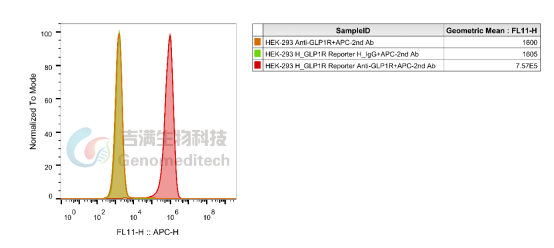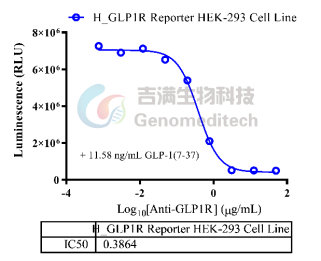Cat. No:GM-51168AB
Product:Anti-GLP1R hIgG1 Antibody(mAb-36986)
Cat. No:GM-51168AB
Product:Anti-GLP1R hIgG1 Antibody(mAb-36986)
GM-51168AB-10 10 μg
GM-51168AB-100 100 μg
GM-51168AB-1000 1mg
Species Reactivity Human
Clone mAb-36986
Source/Isotype Monoclonal Human IgG1 /κ
Application Flow cytometry; Block assay
Specificity Detects GLP1R
Gene GLP1R
Other Names GLP-1; GLP-1R; GLP-1-R
Gene ID 2740
Background This gene encodes a 7-transmembrane protein that functions as a receptor for glucagon-like peptide 1 (GLP-1) hormone, which stimulates glucose-induced insulin secretion. This receptor, which functions at the cell surface, becomes internalized in response to GLP-1 and GLP-1 analogs, and it plays an important role in the signaling cascades leading to insulin secretion. It also displays neuroprotective effects in animal models. Polymorphisms in this gene are associated with diabetes. The protein is an important drug target for the treatment of type 2 diabetes and stroke. Alternative splicing of this gene results in multiple transcript variants.
Storage Store at 2-8℃ short term (1-2 weeks).Store at ≤ -20℃ long term. Avoid repeated freeze-thaw.
Formulation Phosphate-buffered solution, pH 7.2.
Endotoxin < 1 EU/mg, determined by LAL gel clotting assay


Cat. No:GM-51168AB
Product:Anti-GLP1R hIgG1 Antibody(mAb-36986)
GM-51168AB-10 10 μg
GM-51168AB-100 100 μg
GM-51168AB-1000 1mg
Species Reactivity Human
Clone mAb-36986
Source/Isotype Monoclonal Human IgG1 /κ
Application Flow cytometry; Block assay
Specificity Detects GLP1R
Gene GLP1R
Other Names GLP-1; GLP-1R; GLP-1-R
Gene ID 2740
Background This gene encodes a 7-transmembrane protein that functions as a receptor for glucagon-like peptide 1 (GLP-1) hormone, which stimulates glucose-induced insulin secretion. This receptor, which functions at the cell surface, becomes internalized in response to GLP-1 and GLP-1 analogs, and it plays an important role in the signaling cascades leading to insulin secretion. It also displays neuroprotective effects in animal models. Polymorphisms in this gene are associated with diabetes. The protein is an important drug target for the treatment of type 2 diabetes and stroke. Alternative splicing of this gene results in multiple transcript variants.
Storage Store at 2-8℃ short term (1-2 weeks).Store at ≤ -20℃ long term. Avoid repeated freeze-thaw.
Formulation Phosphate-buffered solution, pH 7.2.
Endotoxin < 1 EU/mg, determined by LAL gel clotting assay

